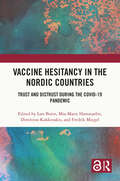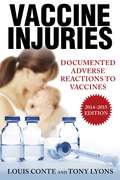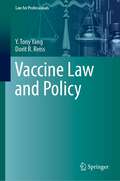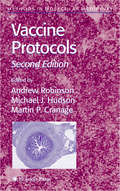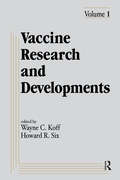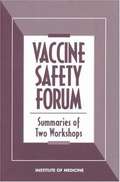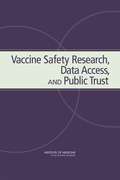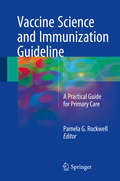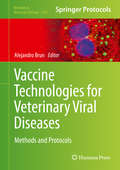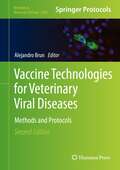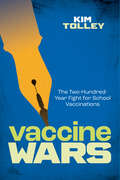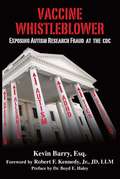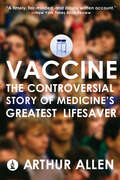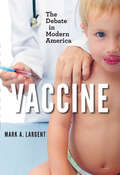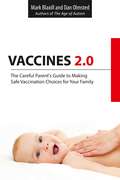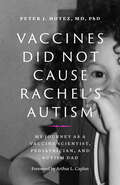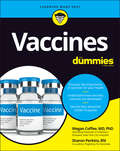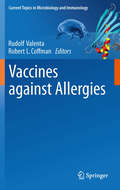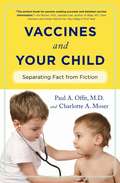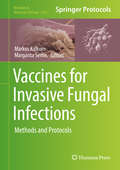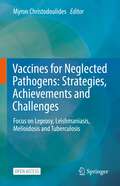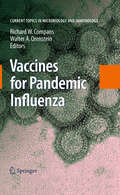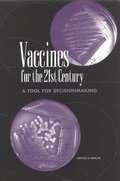- Table View
- List View
Vaccine Hesitancy in the Nordic Countries: Trust and Distrust During the COVID-19 Pandemic
by Mia-Marie Hammarlin Lars Borin Dimitrios Kokkinakis Fredrik MiegelBringing together studies from across the Nordic region, this book examines the challenges brought by the COVID-19 pandemic, with a particular focus on vaccine hesitancy. Shedding light on the political tensions that emerged as a result of the pandemic and the debates that ensued both within and between the Nordic nations, it investigates the vociferous discussions surrounding the COVID-19 vaccines and their presumed negative side effects through the lens of trust; trust in and between the neighbouring countries, in healthcare systems, fellow citizens, and experts; in public authorities, politicians, researchers, journalists, and pharmaceutical companies. The first volume to explore vaccine hesitancy in the Scandinavian context, this ground-breaking volume offers fresh perspectives on vaccine scepticism not as a form of ignorance or lack of knowledge, but as a manifestation of a more fundamental lack of faith in modern government and science. As such, it will appeal to scholars of sociology, politics, anthropology, media studies, communication and cultural studies with interests in public health, popular and political discourse and questions of public trust.The Open Access version of this book, available at http://www.taylorfrancis.com, has been made available under a Creative Commons [Attribution-Non Commercial-No Derivatives (CC-BY-NC-ND)] 4.0 license.
Vaccine Injuries: Documented Adverse Reactions to Vaccines
by Tony Lyons Lou ConteReveals the truth behind the controversial issue of vaccine-related injuries.Proponents declare that vaccines have saved millions of lives. Critics claim that the success is overstated and that vaccines may even be dangerous. <P><P>Many consider mandatory vaccinations a violation of individual rights or religious principles. Many in public health argue that vaccine mandates are critical and justified and that antivaccination sentiment has resulted in outbreaks of preventable childhood illnesses. Vaccine critics point to mainstream medicine's denial of and underreporting of vaccine injury.Vaccine injuries have happened in the past and continue to happen today, and neither the mainstream medical establishment nor the government has ever fully and transparently addressed the issue of vaccine injury. In the 1980s, the United States addressed individual cases of vaccine injury by establishing the NVICP--the National Vaccine Injury Compensation Program--a controversial Department of Health and Human Services program. The NVICP was intended to be "non-adversarial, compassionate, and generous" to vaccine-injury victims. However, many vaccine-injury victims and safety advocates believe that the program is not functioning as intended. There are also concerns that the program is keeping the reality of vaccine injury from public inspection.Vaccine Injuries, a groundbreaking book in the field, reveals cases of vaccine injury from the NVICP--something that has never been offered to the public--and lets readers asses vaccine injuries for themselves.
Vaccine Law and Policy (Law for Professionals)
by Y. Tony Yang Dorit R. ReissVaccine Law and Policy is the first book on vaccine law and policy written specifically for the general public or an educated lay audience without legal background. It offers comprehensive but accessible coverage of key aspects of vaccine law and policy, from product development and intellectual property protections, to regulation, public mandates, and vaccine injury claims. The COVID-19 pandemic sparked a growing interest in learning more about vaccine law and policy, as vaccine development, access, safety and requirements became relevant to hundreds of millions of people worldwide. This book covers United States law in most detail, but the developments and trends described have parallels in many countries, and the United States model and its actions influence others. Some of the most widely used vaccines against COVID-19 - mRNA vaccines – were developed in the United States, and choices made in the United States impact other countries.United States law currently has so much to say about vaccines. From the federal mandate President Biden enacted requiring federal employees to be vaccinated against COVID-19, to the growing number of private employers requiring vaccines to return to work, vaccine law has become a prevalent topic in everyday life. But there is little writing about the legal aspects of vaccines directed at the general public or an educated lay audience without a legal background. Vaccine Law and Policy will not only be invaluable to professionals implementing vaccine law and policy, but also to regulators, public health officials, and scientific researchers.Vaccine Law and Policy covers the wide range of laws and policies that impact the field. These include, among others, regulatory oversight by the FDA, one of the most influential bodies in drug and vaccines regulation worldwide, enforcement, and regulation of the research and development of vaccines; vaccine mandates for children and in the workplace, and medical, religious, and philosophical exemptions to them; patent law and other intellectual property protections such as trademark, trade secret, unfair competition, and copyright law; compensation for vaccine injuries under the National Vaccine Injury Compensation Program (NVICP) and other avenues of liability; safety monitoring; access to vaccines, their promotion, and issues related to funding and costs. The book will also discuss issues related to anti-vaccine movements and vaccine advocacy.
Vaccine Nation: America's Changing Relationship with Immunization
by Elena ConisWith employers offering free flu shots and pharmacies expanding into one-stop shops to prevent everything from shingles to tetanus, vaccines are ubiquitous in contemporary life. The past fifty years have witnessed an enormous upsurge in vaccines and immunization in the United States: American children now receive more vaccines than any previous generation, and laws requiring their immunization against a litany of diseases are standard. Yet, while vaccination rates have soared and cases of preventable infections have plummeted, an increasingly vocal cross section of Americans have questioned the safety and necessity of vaccines. In Vaccine Nation, Elena Conis explores this complicated history and its consequences for personal and public health. Vaccine Nation opens in the 1960s, when government scientists--triumphant following successes combating polio and smallpox--considered how the country might deploy new vaccines against what they called the "milder” diseases, including measles, mumps, and rubella. In the years that followed, Conis reveals, vaccines fundamentally changed how medical professionals, policy administrators, and ordinary Americans came to perceive the diseases they were designed to prevent. She brings this history up to the present with an insightful look at the past decade’s controversy over the implementation of the Gardasil vaccine for HPV, which sparked extensive debate because of its focus on adolescent girls and young women. Through this and other examples, Conis demonstrates how the acceptance of vaccines and vaccination policies has been as contingent on political and social concerns as on scientific findings. By setting the complex story of American vaccination within the country’s broader history, Vaccine Nation goes beyond the simple story of the triumph of science over disease and provides a new and perceptive account of the role of politics and social forces in medicine.
Vaccine Nation: America's Changing Relationship with Immunization
by Elena Conis&“A strikingly honest, fair-minded, and informed chronicle of the vaccine controversy in the United States.&”—Age of Autism By setting the complex story of American vaccination within the country&’s broader history, Vaccine Nation goes beyond the simple story of the triumph of science over disease and provides a new and perceptive account of the role of politics and social forces in medicine.Vaccine Nation opens in the 1960s, when government scientists—triumphant following successes combating polio and smallpox—considered how the country might deploy new vaccines against what they called the &“milder&” diseases, including measles, mumps, and rubella. In the years that followed, Conis reveals, vaccines fundamentally changed how medical professionals, policy administrators, and ordinary Americans came to perceive the diseases they were designed to prevent. She brings this history up to the present with an insightful look at the past decade&’s controversy over the implementation of the Gardasil vaccine for HPV, which sparked extensive debate because of its focus on adolescent girls and young women. Through this and other examples, Conis demonstrates how the acceptance of vaccines and vaccination policies has been as contingent on political and social concerns as on scientific findings. In Vaccine Nation, Conis delivers &“a fascinating account of how routine childhood immunization came to be both a public health success story and a source of bitter controversy&” (James Colgrove, author of Epidemic City and State of Immunity). &“At a moment when, as Conis says, children&’s participation in public life depends on their immunization status, she favors a nuanced view of our complicated relationship with &‘the jab.&’&”—Los Angeles Times
Vaccine Protocols
by Martin P. Cranage Michael J. Hudson Andrew P. RobinsonThis extensively revised, updated, and expanded second edition of a classic laboratory manual applies new understanding of molecular mechanisms to the rational design and development of vaccines. Here the working researcher will find readily reproducible techniques for the development and production of live attenuated vaccines, and vaccines based on inactivated toxins, peptides, and polysaccharide conjugates. New to this edition are cutting-edge chapters on two different viral vectors (Vaccinia and Semliki Forest), lactic acid bacteria for delivery of foreign antigens, incorporation of immunomodulators into plasmid DNA vaccines, construction of tetramer complexes to detect CMI responses, assessment of functional antibody responses, and the use of complete genome sequences for vaccine design. There are also chapters describing more general techniques for vaccine formulation, delivery, and assessment of immune responses, and review discussions of scale-up to manufacture, vaccine quality assurance, and clinical trials.
Vaccine Research and Development: Volume 1: (Vaccine Research and Developments)
by Wayne C. Koff Howard R. SixServing as a complementary series to AIDS Research Reviews - edited by Drs. Wayne C. Koff, Flossie Wong-Staal, and Ronald C. Kennedy (Marcel Dekker, Inc.) - this new series reviews significant advances in immunization research and addresses scientific and public policy challenges for moving candidate vaccines from the laboratory to the population.;Exploring recent progress in immunology, vaccine development and improvement, and clinical trials, Vaccine Research and Developments: analyzes the capacity of lipophilic components to chemically modify peptide and protein antigens and augment their immunogenicity; discusses the potential of noninfectious packaging mutants to serve as prototype vaccines; provides a novel presentation system for peptide vaccines through the multiple antigen peptide approach; examines the current status and future prospects for contraceptive vaccines and offers perspectives for improving pertussis vaccines; furnishes a comprehensive update of vaccine clinical trials; and describes the legal policy aspects involved in developing HIV vaccines.;Containing over 915 useful references, Vaccine Research and Developments is for immunologists, microbiologists and virologists, molecular and cell biologists, infectious disease specialists, pharmacologists, government and industry drug regulatory personnel, and graduate level students in these disciplines.
Vaccine Safety Forum: Summaries of Two Workshops
by Vaccine Safety ForumInformation on a Vaccine Safety Forum
Vaccine Safety Research, Data Access, AND Public Trust
by Committee on the Review of the National Immunization Program's Research Procedures Data Sharing ProgramThe Vaccine Safety Datalink (VSD) is a large, linked database of patient information that was developed jointly by CDC and several private managed care organizations in 1991. It includes data on vaccination histories, health outcomes, and characteristics of more than 7 million patients of eight participating health organizations. Researchers from CDC and the managed care groups have used VSD information to study whether health problems are associated with vaccinations. The subsequent VSD data sharing program was launched in 2002 to allow independent, external researchers access to information in the database. In this report, the committee that was asked to review aspects of this program recommends that two new oversight groups are needed to ensure that the policies and procedures of the VSD and its data sharing program are implemented as fairly and openly as possible.
Vaccine Science and Immunization Guideline
by Pamela G. RockwellThis book is a comprehensive resource on vaccines and immunizations for primary care physicians, advanced practice providers, and trainees. We are now seeing a rise in measles and the potential for rises in other previously rare infectious diseases, significantly due to public and physician misconceptions and misinformation about vaccines. The text addresses this issue by consolidating historical and current advances in vaccine science from how vaccines are developed to CDC recommendations on how and when to administer them. Expert authors also address barriers to improving vaccination rates in the U. S. and offer evidence-based recommendations on overcoming those barriers. This is an essential guide for primary care physicians, family physicians, pediatricians, internists, residents, medical students, mid-level providers, and learners for understanding vaccines and improving preventative care for their patients.
Vaccine Technologies for Veterinary Viral Diseases
by Alejandro BrunThis detailed volume explores the most popular antigen production and delivery strategies that have been tested in veterinary species. Viral vectors as well as genetic and protein subunit vaccines or large scale protein production systems are considered as well as an updated view of most options available for vaccine development, including the data obtained through experimental trials which contributes to the exploration and understanding of the immune mechanisms and immune correlates relevant in protection among different animal species. Written for the highly successful Methods in Molecular Biology series, chapters include brief introductions to their respective topics, lists of the necessary materials and reagents, step-by-step, readily reproducible laboratory protocols and tips on troubleshooting and avoiding known pitfalls. Authoritative and practical, Vaccine Technologies for Veterinary Viral Diseases: Methods and Protocols facilitates access to well-established protocols to those beginning in this interesting and laborious field as well as providing important basic knowledge when attempting a novel vaccine design or platform.
Vaccine Technologies for Veterinary Viral Diseases: Methods and Protocols (Methods in Molecular Biology #2465)
by Alejandro BrunThis second edition includes a collection of antigen production and delivery strategies for vaccine development in veterinary species. New and updated chapters guide readers through protocols for antigen production, experimental antigen delivery and the analysis of immune responses upon vaccination. Written in the format of the highly successful Methods in Molecular Biology series, each chapter includes an introduction to the topic, lists necessary materials and reagents, includes tips on troubleshooting and known pitfalls, and step-by-step, readily reproducible protocols. Authoritative and cutting-edge, Vaccine Technologies for Veterinary Viral Diseases: Methods and Protocols, Second Edition aims to be a useful and practical guide to researches to help further their study in this field.
Vaccine Whistleblower: Exposing Autism Research Fraud at the CDC
by Kevin Barry Robert Kennedy Jr. Dr Boyd HaleyA Firsthand Account from a CDC Insider on the Link between Vaccines and Autism Vaccine Whistleblower is a gripping account of four legally recorded phone conversations between Dr. Brian Hooker, a scientist investigating autism and vaccine research, and Dr. William Thompson, a senior scientist in the vaccine safety division at the Centers for Disease Control and Prevention (CDC). Thompson, who is still employed at the CDC under protection of the federal Whistleblower Protection Act, discloses a pattern of data manipulation, fraud, and corruption at the highest levels of the CDC, the federal agency in charge of protecting the health of Americans. Thompson states, "Senior people just do completely unethical, vile things and no one holds them accountable. ” This book nullifies the government’s claims that "vaccines are safe and effective,” and reveals that the government rigged research to cover up the link between vaccines and autism. Scientific truth and the health of American children have been compromised to protect the vaccine program and the pharmaceutical industry. The financial cost of the CDC’s corruption is staggering. The human cost is incalculable. Vaccine Whistleblower provides context to the implications of Thompson’s revelations and directs the reader to political action.
Vaccine: The Controversial Story Of Medicine's Greatest Lifesaver
by Arthur Allen"A timely, fair-minded and crisply written account."—New York Times Book Review Vaccine juxtaposes the stories of brilliant scientists with the industry's struggle to produce safe, effective, and profitable vaccines. It focuses on the role of military and medical authority in the introduction of vaccines and looks at why some parents have resisted this authority. Political and social intrigue have often accompanied vaccination—from the divisive introduction of smallpox inoculation in colonial Boston to the 9,000 lawsuits recently filed by parents convinced that vaccines caused their children's autism. With narrative grace and investigative journalism, Arthur Allen reveals a history illuminated by hope and shrouded by controversy, and he sheds new light on changing notions of health, risk, and the common good.
Vaccine: The Debate in Modern America
by Mark A. LargentA thoughtful evaluation of the vaccine debate, its history, and its consequences.Since 1990, the number of mandated vaccines has increased dramatically. Today, a fully vaccinated child will have received nearly three dozen vaccinations between birth and age six. Along with the increase in number has come a growing wave of concern among parents about the unintended side effects of vaccines. In Vaccine, Mark A. Largent explains the history of the debate and identifies issues that parents, pediatricians, politicians, and public health officials must address.Nearly 40% of American parents report that they delay or refuse a recommended vaccine for their children. Despite assurances from every mainstream scientific and medical institution, parents continue to be haunted by the question of whether vaccines cause autism. In response, health officials herald vaccines as both safe and vital to the public's health and put programs and regulations in place to encourage parents to follow the recommended vaccine schedule.For Largent, the vaccine-autism debate obscures a constellation of concerns held by many parents, including anxiety about the number of vaccines required (including some for diseases that children are unlikely ever to encounter), unhappiness about the rigorous schedule of vaccines during well-baby visits, and fear of potential side effects, some of them serious and even life-threatening. This book disentangles competing claims, opens the controversy for critical reflection, and provides recommendations for moving forward.
Vaccines 2.0: The Careful Parent's Guide to Making Safe Vaccination Choices for Your Family
by Dan Olmsted Mark BlaxillThe CDC's bloated vaccine schedule has doubled since 1988, after the federal government gave pharmaceutical companies immunity from lawsuits. Autism and other childhood disorders like asthma, ADHD, juvenile diabetes and digestive ailments have skyrocketed. And parents are understandably nervous, desperate for objective guidance that takes those concerns seriously.Vaccines 2.0 looks at the lengthy roster of today's recommended injections, the documented risks that accompany them, and helps parents choose a schedule based on unbiased, uncensored, unconflicted science. From whether to get a flu shot during pregnancy--and how to avoid dangerous mercury if you do--to the Hep B shot within hours of birth, to the controversial Gardasil vaccine for preteens, Vaccines 2.0/i> provides the tools to decide for yourself.The three sections cover: Why should you care? What should you know? What can you do? The exclusive Risk-Reward Assessment assigns a numerical score to each of the 14 recommended vaccines. Also included is information on learning to spot, report and treat side effects; talking to your doctor and finding a sympathetic one if you can't, and comparing alternative schedules if you decide to delay or skip shots. When it comes to your child, it's your choice. Vaccines 2.0 will give you the information you need to choose wisely.
Vaccines Did Not Cause Rachel's Autism: My Journey as a Vaccine Scientist, Pediatrician, and Autism Dad
by Peter J. HotezInternationally renowned medical scientist, frequent media contributor, and autism dad Dr. Peter J. Hotez explains why vaccines do not cause autism.In 1994, Peter J. Hotez's nineteen-month-old daughter, Rachel, was diagnosed with autism. Dr. Hotez, a pediatrician-scientist who develops vaccines for neglected tropical diseases affecting the world's poorest people, became troubled by the decades-long rise of the influential anti-vaccine community and its inescapable narrative around childhood vaccines and autism. In Vaccines Did Not Cause Rachel's Autism, Hotez draws on his experiences as a pediatrician, vaccine scientist, and father of an autistic child. Outlining the arguments on both sides of the debate, he examines the science that refutes the concerns of the anti-vaccine movement, debunks current conspiracy theories alleging a cover-up by the Centers for Disease Control and Prevention, and critiques the scientific community's failure to effectively communicate the facts about vaccines and autism to the general public, all while sharing his very personal story of raising a now-adult daughter with autism.A uniquely authoritative account, this important book persuasively provides evidence for the genetic basis of autism and illustrates how the neurodevelopmental pathways of autism are under way before birth. Dr. Hotez reminds readers of the many victories of vaccines over disease while warning about the growing dangers of the anti-vaccine movement, especially in the United States and Europe. Now, with the anti-vaccine movement reenergized in our COVID-19 era, this book is especially timely. Vaccines Did Not Cause Rachel's Autism is a must-read for parent groups, child advocates, teachers, health-care providers, government policymakers, health and science policy experts, and anyone caring for a family member or friend with autism."When Peter Hotez—an erudite, highly trained scientist who is a true hero for his work in saving the world's poor and downtrodden—shares his knowledge and clinical insights along with his parental experience, when his beliefs in the value of what he does are put to the test of a life guiding his own child's challenges, then you must pay attention. You should. This book brings to an end the link between autism and vaccination."—from the foreword by Arthur L. Caplan, NYU School of Medicine
Vaccines For Dummies
by Sharon Perkins Megan CoffeeInoculate yourself against the confusion and misinformation surrounding vaccines Measles, mumps, and rubella—oh my! Why are we vaccinating our children—and ourselves—against these diseases, and what goes on in our bodies after the needle comes out? Vaccines For Dummies will inform and entertain you about all things vax, including how the first vaccines were discovered, what’s in modern vaccines, how they are tested and approved for use, and why the CDC’s vaccine schedule is what it is. Inside, you’ll also find a complete guide to vaccine benefits, potential side effects, and contraindications, so you’ll be ready when shot time comes. From the very first inoculations hundreds of years ago to the brand new COVID-19 shot, creating immunity to diseases has become a human specialty. If you’re wondering how safe and how necessary it all is, you aren’t alone. In Vaccines For Dummies, we’ll explore the issue from every angle, empowering you to take charge of your wellbeing. With this book, you will: Discover the ABCs of vaccines, including what they’re made of and how they work Learn about each recommended childhood and adult immunization, plus the seasonal flu shot, all with this evidence-based guide Take a journey through vaccine history, meeting the major players of yesterday and today Decide what’s right for your family, with the help of the most recent vaccine science Parents, parents-to-be, adults of any age, and anyone who wants to delve into the microscopic world of pathogens and their arch nemeses (antigens and antibodies) will get a double dose of knowledge from Vaccines For Dummies.
Vaccines against Allergies
by Rudolf Valenta Robert L. CoffmanWe are celebrating this year the hundred years´ anniversary of allergen-specific immunotherapy. In 1911 Leonard Noon published his seminal work "Prophylactic inoculation against hay fever" describing his attempts to achieve active immunity against "grass pollen toxin" by administering increasing doses of grass pollen extract before the grass pollen season to allergic patients. Although it was unknown at that time that allergy represents an immunological hypersensitivity disease, the treatment was effective and many observations made by Noon remained valid until today. Today allergen-specific immunotherapy is well established as the only allergen-specific and disease-modifying treatment for IgE-mediated allergies and has long-lasting effects. In fact, more than 25% of the population suffer from IgE-mediated allergies which therefore represent a major health burden of our society, particularly because untreated allergy often progresses to severe disabling forms of disease, such as asthma and sometimes kills sensitized people through anaphylaxis.
Vaccines and Your Child: Separating Fact from Fiction
by Paul Offit Charlotte MoserPaul A. Offit and Charlotte A. Moser answer questions about the science and safety of modern vaccines. In straightforward prose, they explain how vaccines work, how they are made, and how they are tested. Most important, they separate the real risks of vaccines from feared but unfounded risks. Offit and Moser address parental fears that children may receive too many vaccines too early, that the HPV vaccine may cause chronic fatigue or other dangerous side effects, that additives and preservatives in vaccines cause autism, and that vaccines might do more harm than good. There couldn't be a better moment or more pressing need for this book, which offers honesty-instead of hype-in the quest to protect children's health.
Vaccines for Invasive Fungal Infections
by Markus Kalkum Margarita SemisThis detailed volume focuses on the development of mycosis vaccines via the most common etiological agents of mycoses, such as Aspergillus and Candida species, followed by Cryptococcus, dimorphic fungi, and members of Mucoraceae family of fungi. The book is sectioned into five parts that describe experimental approaches for vaccine candidate discovery, improved vaccine design and delivery, assessment of critical endpoints, analysis of mechanisms of mycosis vaccine protection, and key methods for clinical translation. Written for the highly successful Methods in Molecular Biology series, chapters include introductions to their respective topics, lists of the necessary materials and reagents, step-by-step, readily reproducible laboratory protocols, and tips on troubleshooting known pitfalls. Practical and authoritative, Vaccines for Invasive Fungal Infections: Methods and Protocols provides a standard reference for vaccine researchers, including those who aspire to strengthen their knowledge or desire to acquire a particular technique.
Vaccines for Neglected Pathogens: Focus on Leprosy, Leishmaniasis, Melioidosis and Tuberculosis
by Myron ChristodoulidesThis book reviews successes and (remaining) challenges in vaccine development for the selected Neglected Tropical Diseases (NTD) of Leprosy, Leishmaniasis, Meliodoisis and Tuberculosis, which are a continuous burden for millions of people in affected areas worldwide. Written by frontline researchers, the volume deep-dives into different vaccine strategies, provides biotechnological background information and also tackles animal models in NTD therapeutics research. By bringing together state-of-the-art expert knowledge, the book contributes to the aim of ultimately ending the epidemics of neglected tropical diseases, complying with UN Sustainable Development Goal 3, Health and Well-Being.The volume highlights the activities of the research network VALIDATE (VAccine deveLopment for complex Intracellular neglecteD pAThogEns), funded by the Medical Research Council in the UK. The four NTDs discussed in the book were selected as these are in the focus of VALIDATE’s research.The book targets scientists and clinicians working on NTDs, as well as all readers with a background in biomedicine and interest in vaccine development.This is an open access book.
Vaccines for Pandemic Influenza
by Richard W Compans Walter A. OrensteinThe recent outbreak of disease caused by a novel H1N1 virus has focused global attention on the threat of a new influenza pandemic. Recent years have also seen unprecedented outbreaks of avian influenza A viruses. In particular, highly pathogenic H5N1 viruses have not only resulted in widespread outbreaks in domestic poultry, but have been transmitted to humans resulting in numerous fatalities. The rapid expansion in the geographic distribution of these novel viruses raises the risk that such a virus could cause a global pandemic with high morbidity and mortality. An effective influenza vaccine represents the best approach to prevent and control such an emerging pandemic. However, current influenza vaccines are directed at existing seasonal influenza viruses, which have limited antigenic relationships to the newly emerging virus strains. Concerns about pandemic preparedness have greatly stimulated research activities to develop effective vaccines for pandemic influenza viruses, and to overcome the limitations inherent in current approaches to vaccine production and distribution. These limitations include the use of embryonated chicken eggs as the substrate for vaccine production; which is time-consuming and could involve potential biohazards in growth of new virus strains. Other limitations... more on http://springer.com/978-3-540-92164-6
Vaccines for the 21st Century: A Tool for Decisionmaking
by Institute of MedicineVaccines have made it possible to eradicate the scourge of smallpox, promise the same for polio, and have profoundly reduced the threat posed by other diseases such as whooping cough, measles, and meningitis. What is next? There are many pathogens, autoimmune diseases, and cancers that may be promising targets for vaccine research and development. This volume provides an analytic framework and quantitative model for evaluating disease conditions that can be applied by those setting priorities for vaccine development over the coming decades. The committee describes an approach for comparing potential new vaccines based on their impact on morbidity and mortality and on the costs of both health care and vaccine development. The book examines: Lessons to be learned from the polio experience. Scientific advances that set the stage for new vaccines. Factors that affect how vaccines are used in the population. Value judgments and ethical questions raised by comparison of health needs and benefits. The committee provides a way to compare different forms of illness and set vaccine priorities without assigning a monetary value to lives. Their recommendations will be important to anyone involved in science policy and public health planning: policymakers, regulators, health care providers, vaccine manufacturers, and researchers.
